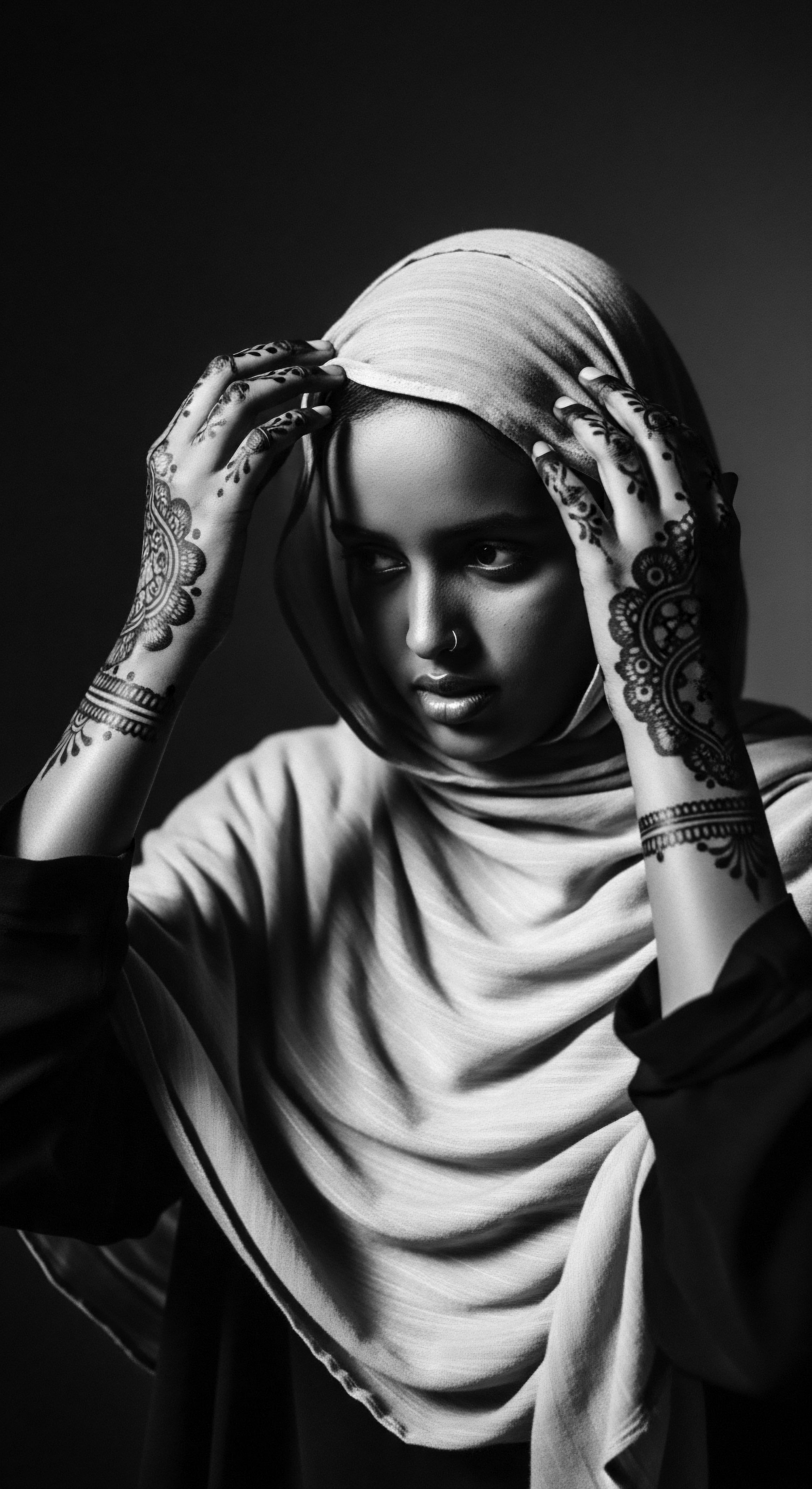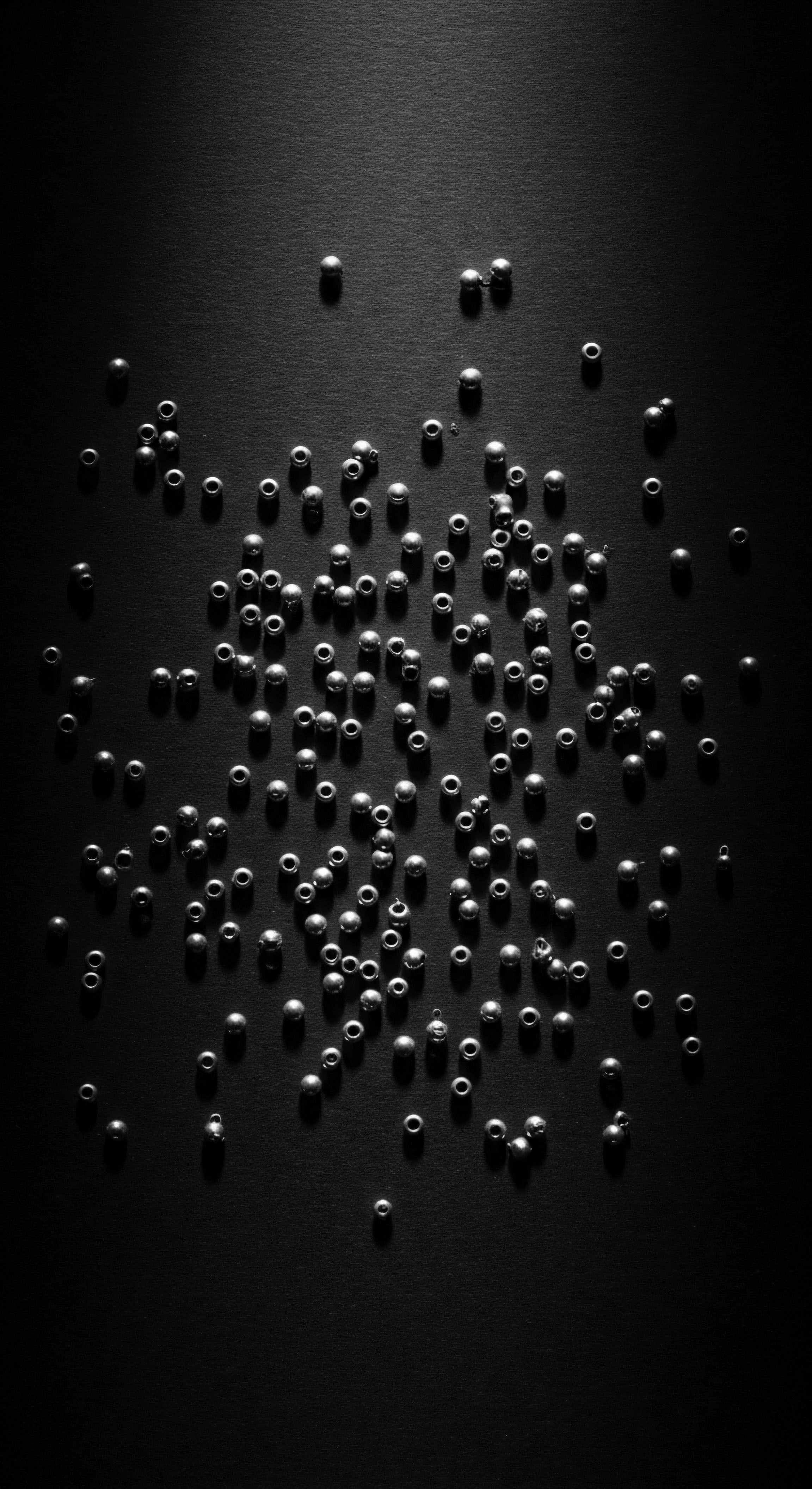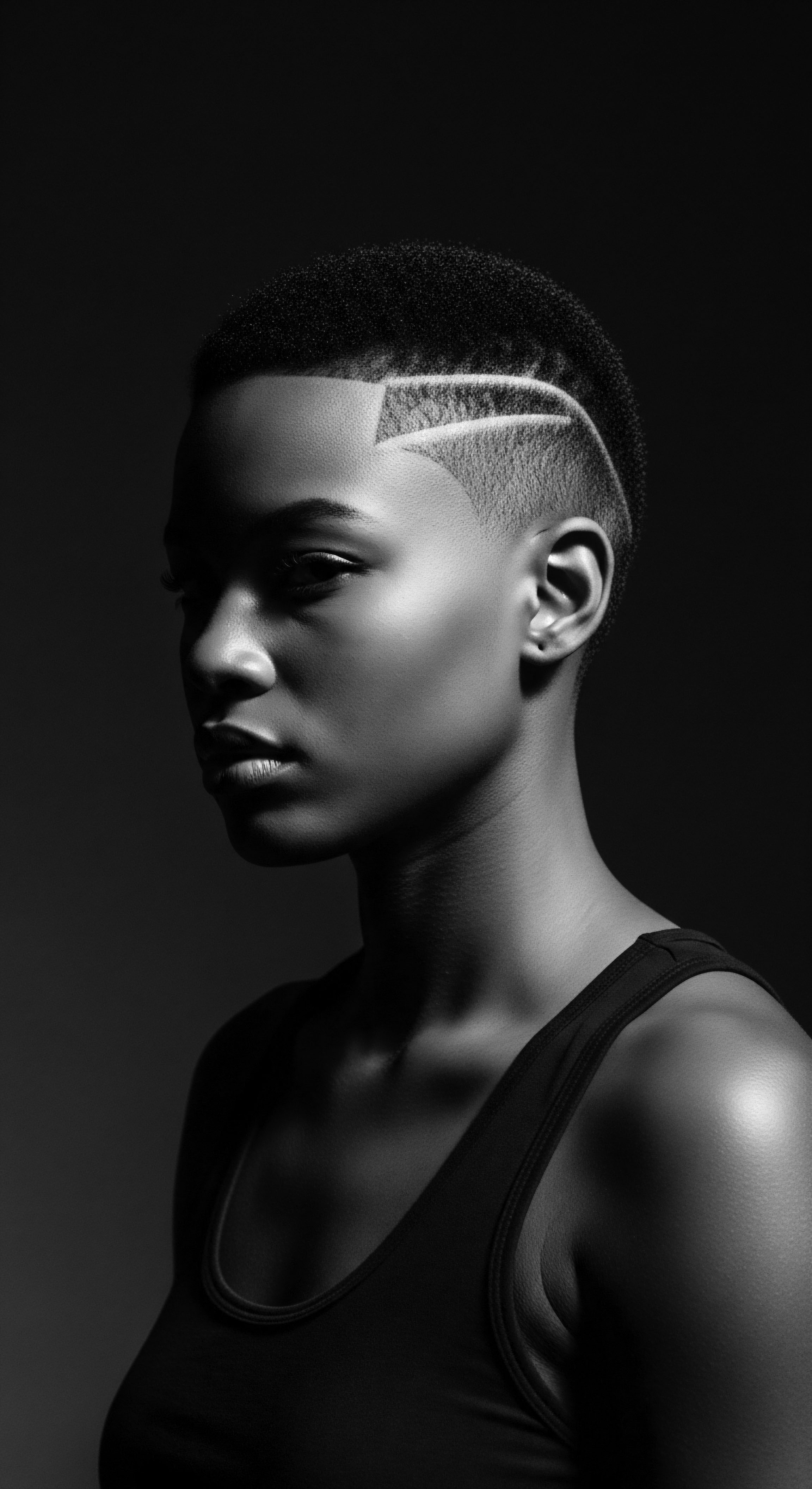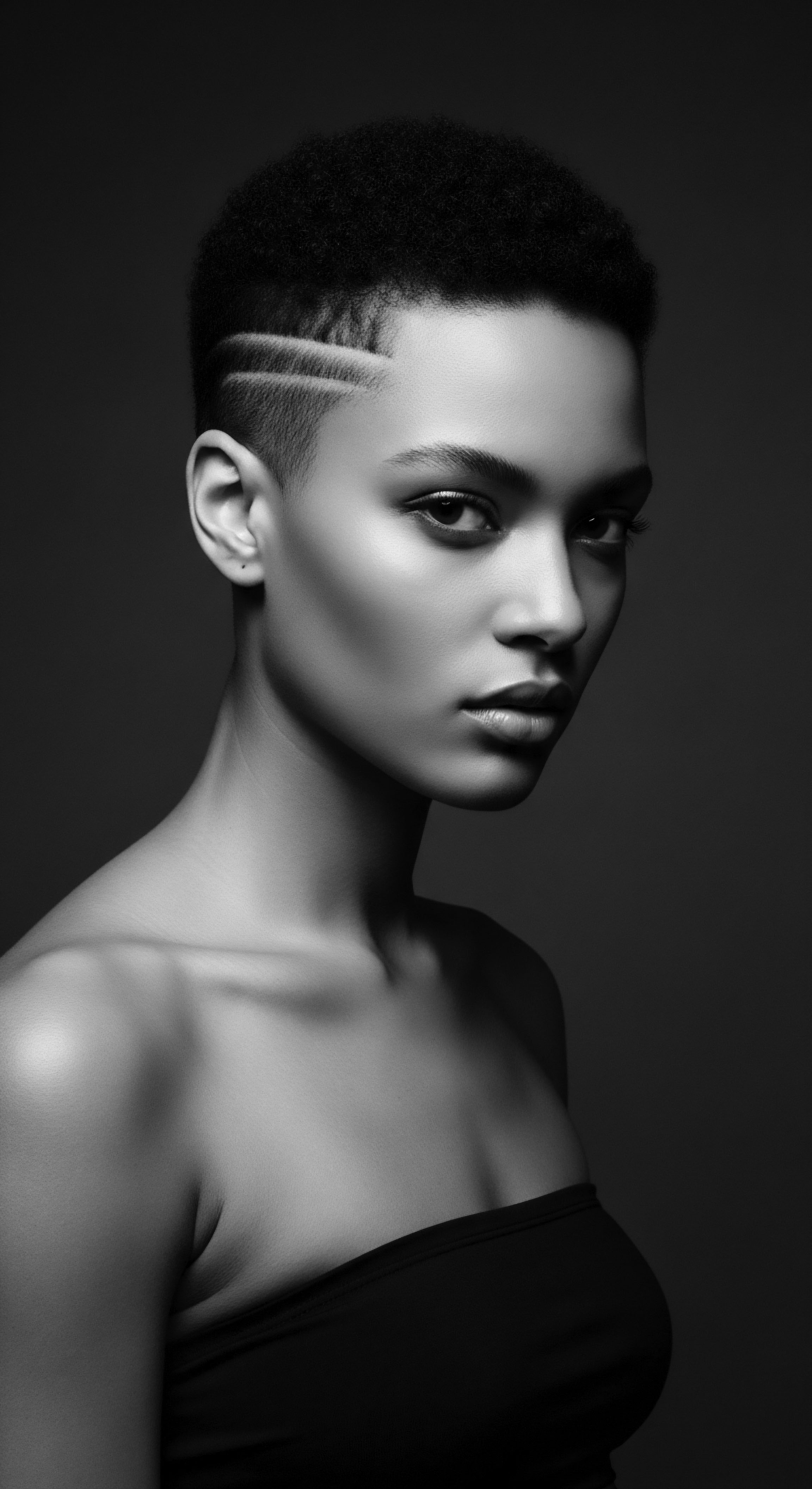
Roots
The coil and kink of textured hair carry echoes from the source, a profound connection to generations past. Each strand is a living archive, whispering tales of sun-drenched landscapes, ancestral ingenuity, and the timeless rituals that shaped identity. When we speak of historical natural dyes on dark textured hair, we are not merely discussing coloration; we are tracing a lineage of care, symbolism, and connection to the Earth’s bounty.
This exploration begins at the very fiber of textured hair, understanding how its intrinsic qualities were honored and celebrated through the application of earth-born pigments. The relationship between hair, color, and heritage is an ancient pact, one that saw adornment as an extension of spirit and community.

Hair’s Deep Structure and Pigment
Textured hair, with its unique helical twists and turns, possesses a remarkable architecture. Its rich, dark hues, spanning from deep umber to a lustrous raven, stem primarily from a melanin called Eumelanin. This particular pigment, abundant in darker hair types, exists in granular forms within the hair shaft, providing a natural depth and resilience. Historical dyeing practices, long before modern chemistry, were rooted in an intuitive understanding of this structure.
Ancient practitioners recognized that certain plant and mineral compounds could interact with the hair’s outer cuticle, depositing color onto the strand or subtly altering its appearance. The methods were often gentle, allowing the hair’s natural vibrancy to remain, a testament to wisdom passed down through touch and observation.
Ancestral practices of hair coloration were not just about changing hue; they were acts of reverence, deeply tied to the inherent structure and spirit of textured hair.

A Heritage Palette from Earth’s Generosity
The palette for coloring dark textured hair in antiquity was drawn directly from the Earth. It included plants, minerals, and other organic substances, each yielding distinct effects. These substances were chosen not only for their coloring properties but often for their conditioning or protective qualities as well. The art of preparing these colorants involved grinding, steeping, and mixing, transforming raw elements into transformative pastes and rinses.
- Henna (Lawsonia inermis) ❉ A cornerstone of traditional hair care across North Africa, the Middle East, and South Asia for millennia, henna imparts reddish-brown tones. It binds to the keratin in the hair, creating a lasting stain. Its history extends to ancient Egypt, where it was employed to conceal gray hairs and to tint wigs. Berber women in North Africa continue to apply henna for its coloring properties and its reputed ability to promote growth and strengthen strands.
- Indigo (Indigofera tinctoria) ❉ Often used in combination with henna, indigo yields blue to blue-black shades. When layered over henna, it creates deep brown or black tones, a traditional method for achieving richer darkness on textured hair.
- Walnut Hulls (Juglans regia) ❉ The outer casings of walnuts, when boiled and concentrated, produce dark brown to black dyes. The compound Juglone present within the hulls reacts with hair protein, imparting a dark hue.
- Red Ochre ❉ A naturally occurring clay pigment rich in iron oxides, red ochre provided reddish-brown tones. While not a dye in the conventional sense, it was used as a cosmetic pigment for both hair and skin in many Indigenous African communities, offering protection from the sun and insects while signifying identity.

What Compounds in Historical Dyes Interacted with Textured Hair?
The interaction between historical natural dyes and dark textured hair rests upon the chemical composition of both the hair and the colorant. Dark hair, particularly, holds a high concentration of Eumelanin, a robust pigment. Plant-based dyes like henna and indigo operate primarily by coating the outermost layers of the hair shaft, the cuticle, or by partially penetrating it. Henna’s active compound, Lawsone, forms a bond with the keratin protein in the hair, creating a stain.
Indigo works similarly, and when applied after henna, the indigo molecules can adhere to the henna-coated strands, deepening the color. This surface-level interaction contrasts sharply with many modern synthetic dyes that penetrate deep into the hair cortex and chemically alter the natural melanin. The traditional methods were less disruptive to the hair’s structural integrity, allowing the hair’s inherent strength and elasticity to remain largely untouched.

Early Pigmentation Practices Beyond Simple Color
The application of these early colorants was rarely a purely aesthetic endeavor. In many African and Indigenous communities, hair adornment, including the addition of color, held profound spiritual, social, and protective meanings. The use of certain pigments could denote age, marital status, tribal affiliation, or ceremonial readiness. Hair, viewed as a connection to the spiritual realm and ancestral wisdom, became a canvas for expressing one’s place within the community and the cosmos.
Consider the Himba People of northern Namibia, a striking example of hair adornment deeply intertwined with cultural identity. For centuries, Himba women have applied a reddish-orange paste called Otjize to their skin and hair. This mixture is a blend of Red Ochre, butterfat, and sometimes aromatic resin from the omuzumba shrub. Otjize gives their distinctive plaited hairstyles a characteristic reddish hue and serves multiple purposes beyond mere coloration.
It provides protection against the sun’s harsh rays and insect bites in their arid environment. Furthermore, the application of otjize is a daily ritual, commencing from puberty for girls, with specific styles indicating different life stages, from youth to marriage. This practice powerfully shows how historical natural “dyes” or pigments were integral to ancestral practices, holistic care, and the very expression of being. It is a living testament to a heritage where beauty rituals served as vital cultural markers.
| Pigment/Source Henna (Lawsonia inermis) |
| Primary Tones on Dark Hair Reddish-brown, deep brown (with indigo) |
| Traditional Cultural or Protective Use Ceremonial use, hair strengthening, cooling scalp, symbol of beauty and blessing. |
| Pigment/Source Indigo (Indigofera tinctoria) |
| Primary Tones on Dark Hair Blue-black, deep black (with henna) |
| Traditional Cultural or Protective Use Achieving darker shades, preventing premature graying, promoting shine. |
| Pigment/Source Walnut Hulls (Juglans regia) |
| Primary Tones on Dark Hair Dark brown, black |
| Traditional Cultural or Protective Use Coloring hair dark, often for a lasting dark tone. |
| Pigment/Source Red Ochre (Iron Oxide Pigment) |
| Primary Tones on Dark Hair Reddish-orange, rust tones |
| Traditional Cultural or Protective Use Sun protection, insect repellent, ceremonial adornment, signaling social status. |
| Pigment/Source Kohl (Stibnite, Lead-based) |
| Primary Tones on Dark Hair Black |
| Traditional Cultural or Protective Use Primarily eye cosmetic, but historically used for hair in ancient Egypt for dark hues. |
| Pigment/Source These traditional colorants offered both aesthetic enhancement and functional benefits within diverse cultural contexts. |

Ritual
The application of natural colorants upon textured hair was seldom a solitary act. It was often a communal ceremony, a tender exchange of hands and stories, a living continuum of ancestral wisdom. These rituals, passed down through matriarchal lines and community elders, transcended simple beautification.
They embodied a reverence for the hair itself, a recognition of its spiritual and social standing within various cultures. The preparation of the dyes, the methods of their application, and the styles they adorned all spoke to a deep, shared heritage.

Application Methods ❉ Hands of Ancient Wisdom
The application techniques for historical natural dyes on textured hair were as diverse as the communities that practiced them. These methods were inherently manual, relying on the skilled hands and intuitive knowledge of the practitioners. Pastes, crafted from finely ground plant materials, were meticulously kneaded and smoothed onto the hair. Rinses, infusions of barks or leaves, were poured over strands, allowing the natural compounds to impart their color and conditioning benefits.
Oils, sometimes infused with pigments, offered both color and protective coatings. The texture of the hair itself, with its coils and curls, lent itself to these tactile applications, ensuring thorough coverage and absorption.
For substances like henna or indigo, the powdered plant material would be mixed with warm water, and sometimes acidic liquids like lemon juice, to create a thick, earthy paste. This paste was then carefully applied section by section, often with the bare hands, ensuring each curl or coil was saturated. The hair might then be wrapped in cloth or leaves to allow the dye to set, a period that could extend for several hours, or even overnight, depending on the desired color intensity. The rhythmic motions of applying these mixtures, the earthy scents, and the patient waiting periods were all part of a larger, lived experience.

Dyeing as Communal Practice
Within many Indigenous African and Afro-diasporic communities, hair care, including coloring, was a profoundly communal activity. It was a time for connection, for sharing stories, for reinforcing social bonds. Grandmothers, mothers, and daughters would gather, their hands working in concert, braiding, twisting, and applying natural treatments.
This communal aspect ensured the continuity of traditional knowledge; recipes for dye mixtures, application techniques, and the cultural meanings associated with specific colors were transmitted across generations through direct participation and oral tradition. This shared experience elevated the act of hair coloring to a powerful cultural touchstone, a testament to collective identity.

How Did Cultural Practices Shape Dye Application on Textured Hair?
Cultural practices profoundly shaped the way historical natural dyes were applied to textured hair, making the process a reflection of social norms, spiritual beliefs, and aesthetic values. The choice of dye, the timing of its application, and the specific hairstyles it accompanied were all imbued with meaning. In some societies, particular shades might be reserved for royalty or ceremonial leaders.
In others, a fresh application of a colorant could mark a rite of passage, such as a girl’s entry into womanhood, or signify mourning or celebration. The communal nature of these practices meant that the application of dyes was not just about transforming the individual’s appearance, but also about reaffirming collective identity and ancestral ties.
For instance, in certain West African cultures, the dyeing of hair, often with indigo for deep black tones, was interwoven with wedding ceremonies. The groom might send the bride baskets containing henna, indigo, and other beautifying agents as part of the bridal preparations, underscoring the role of hair adornment in this significant life event. (Clapperton, 1829) This practice highlights how hair dyeing was integrated into the fabric of life, far beyond superficial trends.

The Seasonal Rhythms of Hair Pigmentation
The timing of dye application often aligned with the rhythms of nature or significant cultural calendars. Ceremonies, festivals, or changes in season could call for fresh coloration, symbolizing renewal, protection, or a new phase of life. The natural cycles of plants also played a role, as certain ingredients might be available only at specific times of the year, dictating when particular treatments could be prepared. This attunement to nature underscores the holistic approach to beauty that characterized ancestral practices.

Tools of Transformation ❉ Gifts from the Earth
The implements used in these historical dyeing rituals were simple, yet effective, crafted from the immediate environment. Grinding stones reduced raw plant materials to fine powders. Wooden bowls and gourds served as mixing vessels. Smooth sticks or fingers became the primary applicators.
These tools, imbued with the spirit of the hands that wielded them, speak to a resourcefulness and an intimate relationship with the natural world. Their very simplicity underscores a profound respect for the inherent qualities of hair and the natural agents used to care for it.
- Grinding Stones ❉ Used to pulverize dried leaves, barks, or minerals into fine powders for paste creation.
- Wooden Bowls and Gourds ❉ Natural containers for mixing dye pastes with liquids like water, oils, or herbal infusions.
- Fingers and Palms ❉ The primary tools for applying the dye, allowing for tactile connection and even distribution across textured hair.
- Plant Leaves or Cloth Wraps ❉ Utilized to cover dyed hair, maintaining warmth and moisture to aid pigment absorption.

Relay
The wisdom embedded in ancestral hair care, particularly concerning natural coloration, does not merely reside in the annals of history. It travels, a living relay, connecting past practices to present understanding and guiding future considerations for textured hair. This deep transmission of knowledge extends beyond superficial aesthetics, reaching into the very science of how these natural elements interacted with the hair shaft, offering both pigment and profound protective benefits. The historical use of natural dyes on dark textured hair provides rich context for contemporary wellness, urging a return to holistic principles and a profound reverence for hair’s natural state.

Beyond Pigment ❉ Medicinal and Protective Benefits
Many historical natural dyes provided more than just a change in hue. They offered significant therapeutic and protective qualities, understood intuitively by ancient communities. These properties often stemmed from the plant’s inherent botanical compounds. For example, Henna is known not only for its reddish stain but also for its astringent and antifungal properties, which can cleanse the scalp and potentially alleviate certain conditions.
The Himba people’s Otjize, a mixture of ochre and butterfat, functions as a natural sunscreen and insect repellent, shielding the hair and scalp from harsh environmental elements in the desert. These multi-functional applications highlight a holistic approach to hair care, where beautification and well-being were inextricably linked.
Traditional hair colorants were often powerful elixirs, simultaneously adorning and protecting the revered strands.

Preserving the Strand’s Integrity
Unlike many modern synthetic dyes that chemically alter the hair’s structure to deposit color, historical natural dyes generally worked by coating the hair shaft or engaging in a more gentle penetration of the cuticle. This approach meant less internal damage to the hair’s keratin protein. For dark textured hair, which can be inherently more prone to dryness and breakage due to its unique curl pattern, this gentle interaction was critical for maintaining elasticity and strength.
The result was color that often deepened with repeated applications, without compromising the hair’s natural vitality. This long-standing method upheld the health of the hair, allowing it to flourish through generations.

What Scientific Insights Validate Ancestral Dye Practices for Textured Hair?
Modern scientific understanding increasingly validates the efficacy and safety of many ancestral dye practices, particularly for textured hair. Research into the chemical components of plants like henna and indigo confirms their ability to bind to keratin, the primary protein in hair, without causing the aggressive oxidation and structural breakdown associated with many contemporary chemical dyes. The Lawsone molecule in henna, for example, forms a direct bond with the hair protein, making the color semi-permanent and less prone to fading.
Studies of traditional botanical extracts continue to reveal beneficial compounds that act as antioxidants, antimicrobials, or conditioners, reinforcing the protective aspects observed by ancient practitioners. This scientific lens allows us to appreciate the profound, empirical knowledge held by those who relied on the earth’s offerings for hair care and adornment.
The deep, dark color of many textured hair types comes from a higher concentration of Eumelanin. Natural dyes like indigo and walnut hulls provide pigments that complement this existing melanin, allowing for subtle darkening or richness. The process is one of deposition and gentle adherence, rather than stripping and re-pigmentation, which helps preserve the hair’s natural moisture balance—a particular concern for textured hair which has a more open cuticle structure.

Ancestral Wisdom, Contemporary Relevancy
The lessons from historical natural dyeing practices for dark textured hair hold significant relevance today. As people increasingly seek alternatives to harsh chemical treatments, the wisdom of ancestral methods provides a compelling blueprint. The contemporary natural hair movement, a reclaiming of ancestral styles and care, finds a strong precedent in these historical uses of plant-based colorants. They offer a path toward adornment that honors the hair’s inherent qualities, reduces exposure to synthetic compounds, and reaffirms a connection to cultural roots and the natural world.
This journey through the historical use of natural dyes on dark textured hair underscores a continuum of knowledge and practice. It reminds us that beauty, particularly for those with textured strands, has always been an intimate connection to heritage, self-care, and the enduring wisdom of generations.
| Aspect Source |
| Ancestral Natural Dyes (e.g. Henna, Indigo, Ochre) Plants, minerals from the natural environment. |
| Early Modern Dyes (e.g. Lead-Based) Inorganic compounds, often toxic metals. |
| Aspect Mechanism |
| Ancestral Natural Dyes (e.g. Henna, Indigo, Ochre) Coat hair shaft, gentle cuticle penetration, bond with keratin. |
| Early Modern Dyes (e.g. Lead-Based) React with sulfur in keratin, forming insoluble metal sulfides for color. |
| Aspect Impact on Hair Health |
| Ancestral Natural Dyes (e.g. Henna, Indigo, Ochre) Generally conditioning, protective, less disruptive to hair integrity. |
| Early Modern Dyes (e.g. Lead-Based) Could be damaging, cause breakage, or lead to scalp irritation. |
| Aspect Safety Profile |
| Ancestral Natural Dyes (e.g. Henna, Indigo, Ochre) Low toxicity, often beneficial to scalp health. |
| Early Modern Dyes (e.g. Lead-Based) Highly toxic, potential for systemic absorption (e.g. lead poisoning). |
| Aspect Color Range |
| Ancestral Natural Dyes (e.g. Henna, Indigo, Ochre) Earth tones ❉ reddish-browns, deep browns, blues, blacks. |
| Early Modern Dyes (e.g. Lead-Based) Often targeted black, but with risks. |
| Aspect The shift from natural, protective colorants to early synthetic, often hazardous, options marks a significant divergence in hair care heritage. |

Reflection
The stories whispered by each curl and coil, steeped in the legacy of ancient colorants, remind us that textured hair is far more than mere fiber. It stands as a living testament to resilience, a sacred connection to the ancestral realm. The historical applications of natural dyes on dark textured hair were not fleeting trends, but profound acts of identity and community, deeply rooted in the land and its generous offerings. From the protective reds of Himba ochre to the deep blacks of West African indigo, these practices embody a holistic wisdom, intertwining beautification with wellness and cultural expression.
This timeless exchange between humanity and the earth’s pigments forms a significant chapter in the grand archive of textured hair heritage. It urges us to look beyond fleeting fashions, recognizing the enduring power held within our strands—a power that draws from the deepest wellsprings of our collective past and continues to shape our present and future. Honoring these ancestral ways means understanding hair not as something to be tamed, but as a vibrant, breathing extension of our very being, a soulful strand indeed.

References
- Clapperton, H. (1829). Journal of a Second Expedition into the Interior of Africa, from the Bight of Benin to Soccatoo. John Murray.
- Cartwright-Jones, C. (2018). History Archives. Ancient Sunrise.
- Kopenawa, D. (2013). The Falling Sky ❉ Words of a Yanomami Shaman. Harvard University Press. (While this specific book primarily focuses on the Yanomami, the general concept of Indigenous communities’ deep connection to natural resources for body adornment, including hair, is a powerful parallel. The Himba example, sourced from search snippets, is the specific citation for cultural practice.)
- Nayak, R. & Singh, A. (2017). Hair Dye and Relaxer Use among Cisgender Women in Embu and Nakuru Counties, Kenya ❉ Associations with Perceived Risk of Breast Cancer and Other Health Effects. Cosmetics, 4(2), 20.
- Parry, J. (2020). Red Ochre ❉ The Colour of Survival. The Thread.
- Siculus, D. (n.d.). Bibliotheca Historica.
- Stewart, R. (2019). The Significance Of Hair In Native American Culture. Sister Sky.
- Tarlo, E. (2016). Entanglement ❉ The Secret Lives of Hair. Oneworld Publications.
- Tiwari, S. (2023). When Was Hair Dye Invented? A Fascinating Journey Through the History of Hair Colouring. YouTube.
- van der Wal, M. (2022). Otjize ❉ The Red Beauty Miracle Of The Himba People. The Guardian Nigeria News.
- Wikipedia. (n.d.). Hair coloring.
- Wikipedia. (n.d.). Henna.
- Wikipedia. (n.d.). Himba people.
